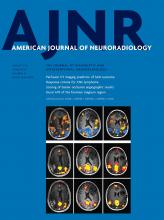Research ArticleNeurointervention
Infarct Growth despite Successful Endovascular Reperfusion in Acute Ischemic Stroke: A Meta-analysis
F. Bala, J. Ospel, B. Mulpur, B.J. Kim, J. Yoo, B.K. Menon, M. Goyal, C. Federau, S.-I. Sohn, M.S. Hussain and M.A. Almekhlafi
American Journal of Neuroradiology August 2021, 42 (8) 1472-1478; DOI: https://doi.org/10.3174/ajnr.A7177
F. Bala
aFrom the Calgary Stroke Program (F.B., J.O., B.K.M., M.G., M.A.A.), University of Calgary, Calgary, Alberta, Canada
bDepartment of Clinical Neurosciences (F.B., B.K.M., M.A.A.), University of Calgary, Calgary, Alberta, Canada
J. Ospel
aFrom the Calgary Stroke Program (F.B., J.O., B.K.M., M.G., M.A.A.), University of Calgary, Calgary, Alberta, Canada
cDepartment of Neuroradiology, Clinic of Radiology, and Nuclear Medicine (J.O.), University Hospital Basel, Basel, Switzerland
B. Mulpur
dCerebrovascular Center and Department of Neurology (B.M., M.S.H.), Neurological Institute, Cleveland Clinic, Ohio
B.J. Kim
eDepartment of Neurology and Cerebrovascular Center (B.J.K.), Seoul National University Bundang Hospital, Seongnam-si, Gyeonggi-do, Republic of Korea
J. Yoo
fYonsei University College of Medicine (J.Y.), Yongin Severance Hospital, Yongin, Korea
B.K. Menon
aFrom the Calgary Stroke Program (F.B., J.O., B.K.M., M.G., M.A.A.), University of Calgary, Calgary, Alberta, Canada
bDepartment of Clinical Neurosciences (F.B., B.K.M., M.A.A.), University of Calgary, Calgary, Alberta, Canada
gDepartment of Radiology (B.K.M., M.A.A.), University of Calgary, Calgary, Alberta, Canada
M. Goyal
aFrom the Calgary Stroke Program (F.B., J.O., B.K.M., M.G., M.A.A.), University of Calgary, Calgary, Alberta, Canada
C. Federau
hInstitute for Biomedical Engineering (C.F.), Swiss Federal Institute of Technology in Zürich, Zürich, Switzerland
S.-I. Sohn
iDepartment of Neurology (S.-I.S.), Keimyung University School of Medicine, Daegu, Korea
M.S. Hussain
dCerebrovascular Center and Department of Neurology (B.M., M.S.H.), Neurological Institute, Cleveland Clinic, Ohio
M.A. Almekhlafi
aFrom the Calgary Stroke Program (F.B., J.O., B.K.M., M.G., M.A.A.), University of Calgary, Calgary, Alberta, Canada
bDepartment of Clinical Neurosciences (F.B., B.K.M., M.A.A.), University of Calgary, Calgary, Alberta, Canada
gDepartment of Radiology (B.K.M., M.A.A.), University of Calgary, Calgary, Alberta, Canada

References
- 1.↵
- Yoo AJ,
- Chaudhry ZA,
- Nogueira RG, et al
- 2.↵
- Zaidi SF,
- Aghaebrahim A,
- Urra X, et al
- 3.↵
- Regenhardt RW,
- Etherton MR,
- Das AS, et al
- 4.↵
- De Meyer SF,
- Denorme F,
- Langhauser F, et al
- 5.↵
- 6.↵
- 7.↵
- 8.↵
- 9.↵
- 10.↵
- Sterne JA,
- Hernán MA,
- Reeves BC, et al
- 11.↵
- 12.↵
- Andrapalliyal N,
- Handshoe Lacy S,
- Mulpur B, et al
- 13.↵
- 14.↵
- 15.↵
- 16.↵
- 17.↵
- Inoue M,
- Mlynash M,
- Christensen S, et al
- 18.↵
- 19.↵
- 20.↵
- 21.↵
- 22.↵
- 23.↵
- Khatri R,
- McKinney AM,
- Swenson B, et al
- 24.↵
- 25.↵
- 26.↵
- 27.↵
- 28.↵
- 29.↵
- 30.↵
- Harston GW,
- Carone D,
- Sheerin F, et al
- 31.↵
- Simard JM,
- Kent TA,
- Chen M, et al
- 32.↵
- 33.↵
- Broocks G,
- Faizy TD,
- Flottmann F, et al
- 34.↵
- 35.↵
- Kaesmacher J,
- Dobrocky T,
- Heldner MR, et al
- 36.↵
- 37.↵
- Rangaraju S,
- Aghaebrahim A,
- Streib C, et al
- 38.↵
- 39.↵
- 40.↵
- 41.↵
- Almekhlafi MA,
- Modi J,
- Menon B, et al
- 42.↵
- 43.↵
- Shuaib A,
- Butcher K,
- Mohammad AA, et al
- 44.↵
- An JQ,
- Cheng YW,
- Guo YC, et al
- 45.↵
- 46.↵
- 47.↵
- Chamorro A,
- Amaro S,
- Castellanos M, et al
- 48.↵
- 49.↵
- 50.↵
- Chalela JA,
- Kidwell CS,
- Nentwich LM, et al
- 51.↵
- 52.↵
In this issue
American Journal of Neuroradiology
Vol. 42, Issue 8
1 Aug 2021
Advertisement
F. Bala, J. Ospel, B. Mulpur, B.J. Kim, J. Yoo, B.K. Menon, M. Goyal, C. Federau, S.-I. Sohn, M.S. Hussain, M.A. Almekhlafi
Infarct Growth despite Successful Endovascular Reperfusion in Acute Ischemic Stroke: A Meta-analysis
American Journal of Neuroradiology Aug 2021, 42 (8) 1472-1478; DOI: 10.3174/ajnr.A7177
0 Responses
Infarct Growth despite Successful Endovascular Reperfusion in Acute Ischemic Stroke: A Meta-analysis
F. Bala, J. Ospel, B. Mulpur, B.J. Kim, J. Yoo, B.K. Menon, M. Goyal, C. Federau, S.-I. Sohn, M.S. Hussain, M.A. Almekhlafi
American Journal of Neuroradiology Aug 2021, 42 (8) 1472-1478; DOI: 10.3174/ajnr.A7177
Jump to section
Related Articles
- No related articles found.
Cited By...
- Designing clinical trials for bridging cerebroprotection in the era of mechanical thrombectomy: are we missing the point?
- Head down tilt 15{degrees} increases cerebral perfusion before recanalization in acute ischemic stroke. A pre-clinical MRI study
- Infarct Evolution in Patients with Anterior Circulation Large-Vessel Occlusion Randomized to IV Alteplase and Endovascular Treatment versus Endovascular Treatment Alone
This article has not yet been cited by articles in journals that are participating in Crossref Cited-by Linking.
More in this TOC Section
Similar Articles
Advertisement











